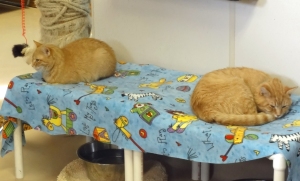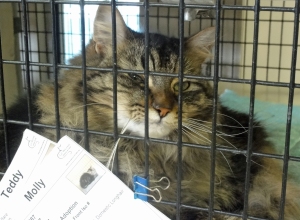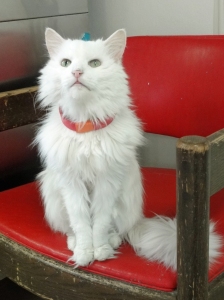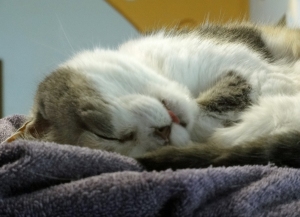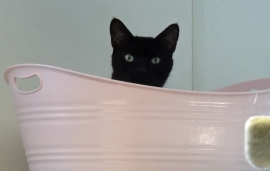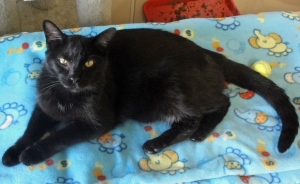My name is Cathy Cowan Becker, and I live in Columbus, Ohio. I will be swimming a marathon (26.2 miles) through the month of June to raise money for two organizations – Cat Welfare Association, a cat shelter in Columbus, and Lions, Tigers & Bears, a big cat and exotic animal sanctuary in Alpine, Calif.
The goal is to raise $2600 – $100 for each mile – with half going to each group. On this blog I will keep track of the miles I swim, talk about issues facing big and small cats, and feature adoptable cats from Cat Welfare and the big cat residents of Lions, Tigers and Bears.
Donation page for Lions, Tigers & Bears – http://www.razoo.com/story/Big-Cats-Little-Cats1
Donation page for Cat Welfare Association – http://www.razoo.com/story/Big-Cats-Little-Cats2
I hope you will consider donating to both!
MY STORY
This month I am turning 50 years old. Hard to believe because I don’t feel 50. But I have been feeling more sluggish lately, and you know what they say – use it or lose it.
So this month I decided to do a swim marathon – 26.2 miles in the pool. This works out to about a mile a day. And I decided to use this event to raise money for my favorite cause – cats both big and small.
THEY NEED OUR HELP
Both big and small cats need our help. Anyone who owns a small cat knows what wonderful companions they are. Yet pretty much everyone has seen stray and feral cats wandering the streets.
In Central Ohio alone there are an estimated 1 million stray and feral cats. No one knows how many there are nationally, but estimates range from 30 million to 90 million.
Cat Welfare Association in Columbus, Ohio, has been working since 1945 to help these cats. This no kill shelter takes in friendly stray, injured and pregnant cats to be rehomed after a spay-neuter, preventive shots, and any needed medical treatment. The free-roaming facility houses about 300 cats at a time and adopts out about 1,000 a year to new homes.
Cat Welfare also addresses the root cause of cat overpopulation through a spay-neuter program for low-income cat owners and TNR program for colony cat caretakers. Pet owners can get a low-cost voucher to take their pets to a local veterinarian, while feral cats are fixed for only $10. The Altering Fund helped 2,351 cats in 2012 and 31,248 since 1990 get this important surgery.
Find out more about Cat Welfare Association at http://www.catwelfareohio.com.
BIG CATS
Big cats are disappearing from the planet. In the past 30 years lion populations have dwindled 80 percent, and fewer than 5,000 tigers are left in their natural habitat. Meanwhile, breeding and selling of these animals has skyrocketed – there are more tigers in captivity than in the wild.
Why has this happened? One reason is the USDA allows direct contact with tiger cubs from 6 to 12 weeks, spurring unscrupulous people to breed them for photo and petting booths. Once these animals grow up, there are few places for them to go. Accredited zoos don’t take them (zoos have their own breeding programs that follow strict genetics), while accredited sanctuaries are full.
Many big cats end up in substandard roadside zoos or private hands. Most private citizens don’t have the finances or training to handle the needs of these magnificent creatures, evolved to wander over wide territories and hunt large prey. Big cats of any sort do not make good pets.
One sanctuary working on this problem is Lions, Tigers & Bears in Alpine, Calif. Accredited by both the Global Federation of Animal Sanctuaries and American Sanctuary Association, LTB houses dozens of big cats on a 93-acre ranch west of San Diego. It has 17 species including lions, tigers, cougars, bobcats, leopards, servals, as well as bears and farm animals.
LTB IN OHIO
LTB’s founder, Bobbi Brink, has a special relationship with Ohio. For years, Ohio’s lack of regulations on dangerous wild animals made it a magnet for the exotic animal trade. New legislation passed last year in the wake of the tragic events in Zanesville prompted many private owners to close up shop.
Unfortunately, people trying to place big cats have few options. That’s where Bobbi came in. She and a team traveled to Ohio to meet with multiple private owners and find new homes for dozens of big cats and other animals.
Then, with support from groups like International Fund for Animal Welfare and Humane Society of the United States, her team transported these animals to accredited facilities across the country. Ohio owes Bobbi and Lions, Tigers & Bears a debt of gratitude for helping these animals get out of substandard conditions and into good homes.
Find out more about Lions, Tigers & Bears at http://lionstigersandbears.org.




